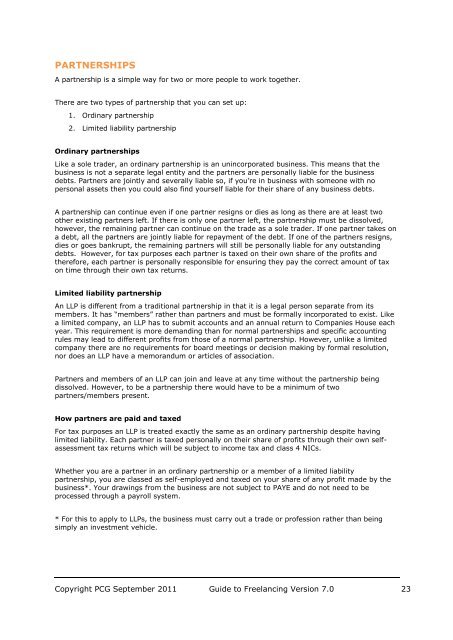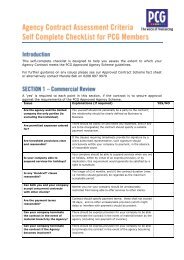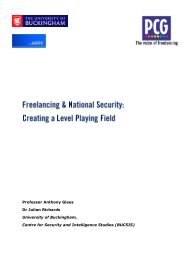Guide to Freelancing - PCG
Guide to Freelancing - PCG
Guide to Freelancing - PCG
Create successful ePaper yourself
Turn your PDF publications into a flip-book with our unique Google optimized e-Paper software.
PARTNERSHIPS<br />
A partnership is a simple way for two or more people <strong>to</strong> work <strong>to</strong>gether.<br />
There are two types of partnership that you can set up:<br />
1. Ordinary partnership<br />
2. Limited liability partnership<br />
Ordinary partnerships<br />
Like a sole trader, an ordinary partnership is an unincorporated business. This means that the<br />
business is not a separate legal entity and the partners are personally liable for the business<br />
debts. Partners are jointly and severally liable so, if you‟re in business with someone with no<br />
personal assets then you could also find yourself liable for their share of any business debts.<br />
A partnership can continue even if one partner resigns or dies as long as there are at least two<br />
other existing partners left. If there is only one partner left, the partnership must be dissolved,<br />
however, the remaining partner can continue on the trade as a sole trader. If one partner takes on<br />
a debt, all the partners are jointly liable for repayment of the debt. If one of the partners resigns,<br />
dies or goes bankrupt, the remaining partners will still be personally liable for any outstanding<br />
debts. However, for tax purposes each partner is taxed on their own share of the profits and<br />
therefore, each partner is personally responsible for ensuring they pay the correct amount of tax<br />
on time through their own tax returns.<br />
Limited liability partnership<br />
An LLP is different from a traditional partnership in that it is a legal person separate from its<br />
members. It has “members” rather than partners and must be formally incorporated <strong>to</strong> exist. Like<br />
a limited company, an LLP has <strong>to</strong> submit accounts and an annual return <strong>to</strong> Companies House each<br />
year. This requirement is more demanding than for normal partnerships and specific accounting<br />
rules may lead <strong>to</strong> different profits from those of a normal partnership. However, unlike a limited<br />
company there are no requirements for board meetings or decision making by formal resolution,<br />
nor does an LLP have a memorandum or articles of association.<br />
Partners and members of an LLP can join and leave at any time without the partnership being<br />
dissolved. However, <strong>to</strong> be a partnership there would have <strong>to</strong> be a minimum of two<br />
partners/members present.<br />
How partners are paid and taxed<br />
For tax purposes an LLP is treated exactly the same as an ordinary partnership despite having<br />
limited liability. Each partner is taxed personally on their share of profits through their own selfassessment<br />
tax returns which will be subject <strong>to</strong> income tax and class 4 NICs.<br />
Whether you are a partner in an ordinary partnership or a member of a limited liability<br />
partnership, you are classed as self-employed and taxed on your share of any profit made by the<br />
business*. Your drawings from the business are not subject <strong>to</strong> PAYE and do not need <strong>to</strong> be<br />
processed through a payroll system.<br />
* For this <strong>to</strong> apply <strong>to</strong> LLPs, the business must carry out a trade or profession rather than being<br />
simply an investment vehicle.<br />
Copyright <strong>PCG</strong> September 2011 <strong>Guide</strong> <strong>to</strong> <strong>Freelancing</strong> Version 7.0 23








